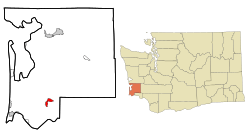Chetlo Harbor, Washington facts for kids
Quick facts for kids
Chetlo Harbor, Washington
|
|
|---|---|

Location of Naselle, Washington
|
|
| Country | United States |
| State | Washington |
| County | Pacific |
| Area | |
| • Water | 0.0 sq mi (0 km2) |
| Elevation | 33 ft (10 m) |
| Population
(ca. 1910)
|
|
| • Total | 50 |
| Time zone | UTC-8 (Pacific (PST)) |
| • Summer (DST) | UTC-7 (PDT) |
| Area code(s) | 360 |
| FIPS code | 53-48015 |
| GNIS feature ID | 1512495 |
Chetlo Harbor was once a small settlement, or town, located in the southwest part of Washington State. It was found at the mouth of the Naselle River, in the southeast corner of Willapa Bay. Over the years, this place was also known by other names like Cougar Bend, Napoleon, and Stanley.
At its busiest time, about 50 people lived in Chetlo Harbor. The main businesses in the area included fishing for salmon and canning them, cutting down trees (logging), and a mining company. The word "Chetlo" comes from the Chinook Jargon language, and it means "oyster."
Contents
A Look Back: Chetlo Harbor's Story
Life in an Isolated Area
Chetlo Harbor was a very isolated place. There were no roads along the lower part of the river. People mostly traveled by boat. Back then, gas engines were not very dependable. Only a few power boats were on the whole river.
A boat from South Bend would visit once a week. It brought mail, supplies, and any passengers. Because travel was so hard, there were many one-room schools. They were built all along the river, sometimes just a couple of miles apart. This made it easier for children to get to school.
Moving Logs by Water
Moving cut logs was a big job. Large boats called tugs were used to pull them. There was a whole group of these tugs, like the Flora Brown, Agnes, Launel, Myrtle, Queen, and Defender. The Defender was the newest and strongest tug.
However, the Defender was actually too powerful. When it pushed the logs, they would go under the special "tailstick" at the back. This caused logs to be lost, and trying to get them back almost ruined the owner financially. People realized they needed to improve transportation in the area.
Starting a New Town
Someone decided to create a proper town to help with the isolation. A new town was planned, or "platted," a little way downriver from where the highway bridge is now. It was on the west side of the river, near an old mill called Sunshine Mill. The mill's equipment had been moved years before.
The town was first called Napoleon, but later its name changed to Chetlo Harbor. A dock was built, and a store opened. People also started buying plots of land to build on.
The Unfinished Sawmill
A sawmill project began across the water. However, there wasn't enough water there when the tide was low. The mill was never fully built. When it was almost finished, it caught fire and was completely destroyed. It was never rebuilt. There was a wooden walkway, or boardwalk, that went from the town through the woods to the mill site. It was about a quarter of a mile long.
The Salmon Cannery
The Chetlo Harbor Packing Company was a business that processed salmon. It was owned by two brothers, Joe and Douglas Rowell, and their cousin, an attorney named Horne. Before they had a cannery, they would catch fish and sell them to other buyers.
In 1914, they built their own cannery. Nick Kussman was hired to manage the operations. The cannery was ready for the fall salmon season that year. They managed to can 10,000 cases of salmon. However, the cannery faced financial difficulties and stopped operating in 1915. It had provided jobs for about 30 to 40 people. A post office was also opened in Chetlo Harbor on December 19, 1911, but it closed a few years later on February 15, 1918.

